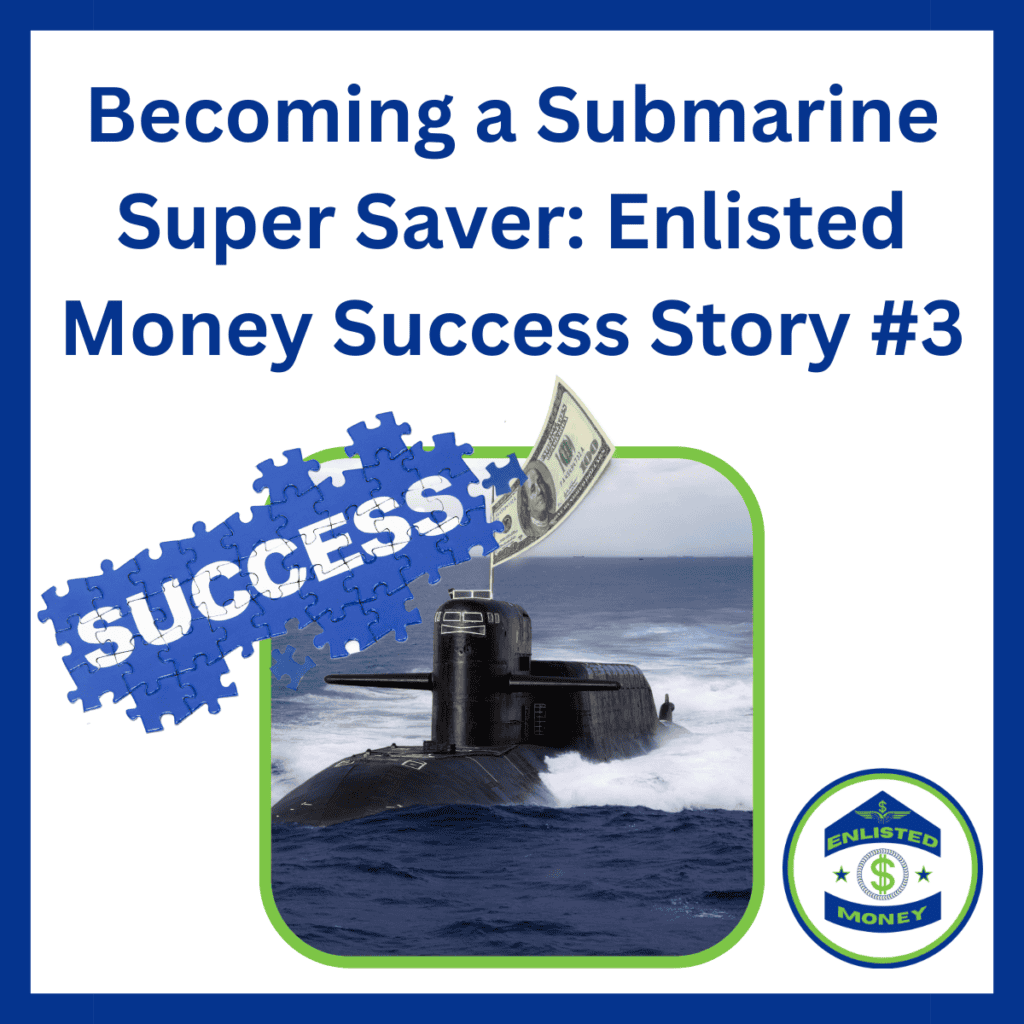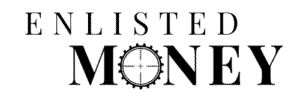
Hear how one Sailor went from being deep in debt, struggling with money management, to a firm foundation within the span of about one enlistment. You’ll want to read the one to the end to hear their amazing story.
Late to Enlist
I joined the military late. I went to school, graduated, had a good GPA, and fell on my face in the real world. I couldn’t find a real job in my field, I worked on a farm for over ten years, and it was time for a change. I wanted out.
I didn’t care about commissioning, and I felt that if I really…really didn’t like the Military, the Enlisted side was the easier option. I then volunteered for the Submarine Service. I was never fantastic with money. I over-drafted my account on an almost monthly basis, had over $60k in student loans, and didn’t realize how much that actually was. Then, I became an E-3.
Half-Month’s Pay to Debt and Overspending
Half of my monthly pay was now going to pay off my student loans, half month pay times three years is what it turned into. I gained some rank, received BAH, and got a credit card. I now had money, and no knowledge of what to do with it. I continued spending with no regard for any future endeavors, I bought a car, racked up credit card debt, got into trading penny stocks and options, and then I reenlisted.
Playing with Penny Stocks
I ended up making some money in the stock market. I was lucky, and then very unlucky. I realized I could make actual wealth in the stock market over a longer time horizon than I was looking. I started researching, bought a bunch of courses that all said the same thing, “use these tips and tricks to get money fast.” When in reality their main income source was probably selling those courses and not doing what they were actually teaching.
The Beginnings of Financial Literacy
I spent COVID learning about investing, financial literacy, anything and everything about the stock market. I, however, did not fully change my behavior yet. I increased my TSP allocation to 25% in 2020 and thought I was well on my way to financial success.
Spending Strikes Again
In 2021, I bought a house using a VA loan with a 0% down payment. I then furnished this home using my credit card and thought that because I was now making more money, I could spend more. My lifestyle creep and behavior turned into having over $15k on one credit card.
I realized my credit card usage was too high, so I opened another and then ran up that balance to a little over $10k. Now…$25k in Credit card debt, still over $30k in Student Loans due to not putting any more money than the minimum, and owning a house.
A Stark Realization and Starting New Habits
I fully realized my habits were making me broke. I was on a hamster wheel trying to build wealth while paying down high-interest debt. In 2023 I took my TSP down to 0%, cut my spending to the bare minimum, made a real adult budget, picked up a side job of Door-Dashing in my off time (with my Command’s approval), and focused on paying off all my high-interest debt.
Kicking the Debt Habit
During the year, I eliminated my credit card debt, took my student loans down to $10k, built a three-month emergency fund in a high-yield savings account, and was meritoriously promoted. When there was downtime during the year, I was making new budgets, planning out my next few months of spending, and extrapolated compound interest based off different percentage amounts of funding, return, and inflation.
Helping Others in the Process
I went on to become a Command Financial Specialist, and shared my experience/pitfalls with the younger Sailors, all while making budgets for them to get out of their own debt issues. I made and gave training, and fully committed to my financial future.
Fast Forward to the Present
Now, in 2024, I carry $0 in high-interest debt monthly, never accruing interest, have 6 months of an emergency fund in a high-yield savings account, contribute 50% of my base pay to my TSP (which comes out to be $1,952 per month ($23,000) maxing out my TSP for the year), put $584 per month ($7,000/year) towards my Roth IRA, and put $504 ($6,000/year) per month towards my brokerage account.
Using Their Story to Help Others
I was already used to paying $3,000 toward debt, so now I’m using it to become financially free before I exit the military. I now plan on furthering my education and becoming a financial planner while in the military, helping as many service members as I can throughout my career get on their own stronger financial footing, thereby increasing our overall readiness.
Financial Readiness is Mission Readiness
When we don’t have to focus on money issues, we can better focus on whatever else we need to!
Enlisted Service Members Can Build Wealth Too!
I hope my experience shows that by enlisting in the military you can gain financial knowledge, wealth, and freedom through service. Personal finance is personal for a reason; not all situations are the same. The journey is not a straight shot toward wealth. There will be ups and downs throughout, but each time we fall we become stronger and smarter to better handle our next mission.
My net worth went from -$60k (in the negative) prior to joining the military, to now over $150k. It has taken almost 8 years, but I would not change any of it. Thank you for reading.
***Break***
Enlisted Money Response
Thanks so much for sharing your story! I think your personal journey coupled with experience and training will make you very effective at helping other service members get on the path to building wealth. There are a lot of parallels in our stories. I do want to highlight a few things I feel are really important.
Your Path to Financial Freedom Isn’t a Straight Line
As the Submarine Super-Saver’s story illustrates, life doesn’t follow straight lines. They got a little bit of a late start, then dug themselves a couple of holes. After trying the “get rich quick” schemes without success (no surprise there!), they made a pivot and started using more tried and true methods.
Even after starting to get financially educated, they had some hiccups and spending “relapses” along the way. But what’s important is they kept working at it and followed the process. Even if you get tripped up on your own financial independence journey, you get course correct and “right the ship” as needed.
Using the Right Tools
I think it’s valuable to point out some key tools this particular Sailor used. These include a budget, the Thrift Savings Plan, Roth IRA, high-yield savings account (HYSA), taxable brokerage account, and emergency fund. All of these are useful tools that you should look into.
A Budget
Having a budget, no matter what it looks like, is an essential tool. You have to have some type of system for cash flow management. Otherwise, you have no idea where your money is going. This is even more important if you still use debt instruments like credit cards to pay for things.
Regardless, your budget is the foundational tool for organizing your finances.
Thrift Savings Plan
Your Thrift Savings Plan (TSP) is the military equivalent of a 401k. You can even get employer matching for those in the Blended Retirement System (BRS). This is literally free money for the taking. I always suggest service members get their TSP match.
The TSP is a simple, low-cost way to save for retirement. I still use it personally because it’s the easiest way to automate my retirement savings.
Roth IRA
There are lots of benefits to having a Roth IRA. They are a more flexible way to save for retirement, but the contribution limits (how much you can add each year) is much lower than your TSP. I talk about the hidden benefits the Roth TSP and Roth IRA more in this article.
High-Yield Savings Account (HYSA)
A high-yield savings account (HYSA) isn’t necessarily magical. It’s just a savings account that pays you more in interest than a typical brick-and-mortar bank. However, it’s easy money and helps keep up with inflation.
You can read more about HYSAs here.
Taxable Brokerage Account
A taxable brokerage account is a good account to have. I use ours for any “just in case” savings we have. So, if we’re saving up money and don’t need it within about 5 years, it’ll get put into the taxable brokerage account. We also use it for specific savings goals like my retirement transition fund.
Emergency Fund
It’s really interesting how few emergencies happen when you have an emergency fund. Before we had an emergency fund, we were constantly in emergency or crisis mode. However, we’ve never actually had to use our emergency fund. I guess it really is a “Murphy repellent,” as Dave Ramsey likes to say.
Final Takeaways and Call to Action
The main thing I took away from this Sailor’s story is how concentrated effort can yield fantastic results. In the course of about one enlistment, they went from being deep underwater (pun intended) to building a solid, wealth-building foundation. They gained some promotions, but their savings rate was the key to their success.
If you feel like you’re behind or you’ll never get there, take a few notes from this Sailor’s journey and plot your own course. All it takes is sustained effort over time, and you’ll be amazed at what you can accomplish!
